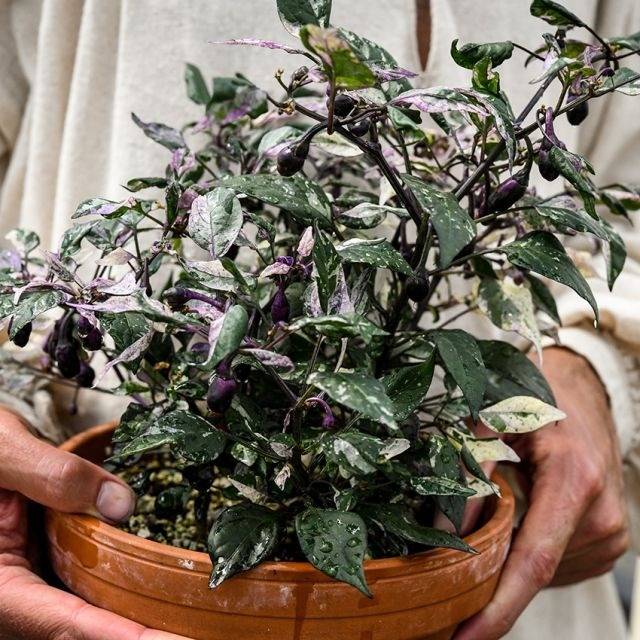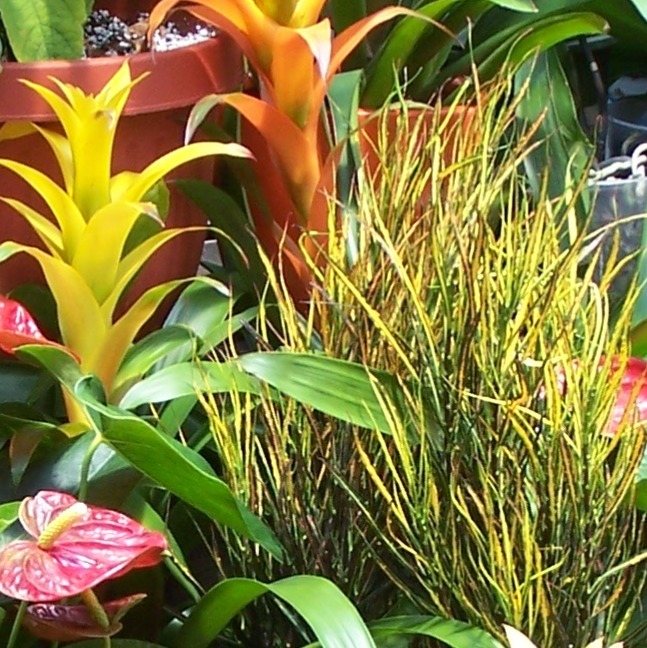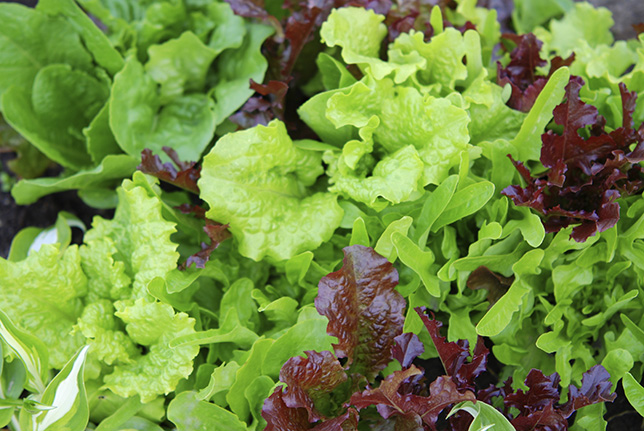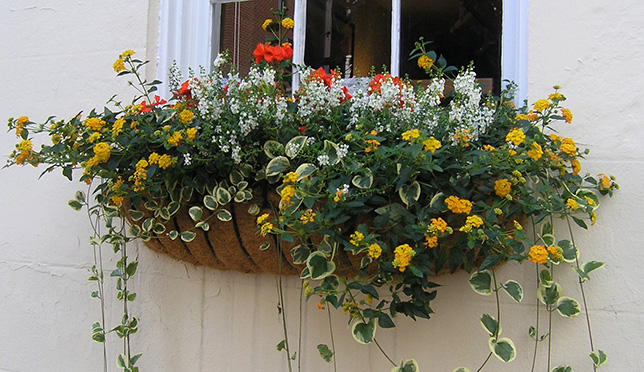Depending on your location, you may be just arranging some cool weather annuals in your spring containers, or you may be already looking toward changing those out for a permanent summer planting. Either way, once you know you're frost free it will be time to trot off to the nursery and decide what will fill your window hayracks and baskets this year. We'd like to suggest something different for those of you bored with the same old, same old. So if you're feeling just a little adventurous (and maybe a bit hungry), read on!

Unique Plants for Window Boxes and Hanging Baskets
Edible Plants for Early Season Containers:
Edible plants and container gardening are still hot trends, so that means more dwarf plants on the market than ever before. Spring is the season for many of our healthiest vegetables, and they can easily be grown in your window boxes, hayracks, or baskets, either alone or added to other cool-weather flowers. These are some of the prettiest, so you can preserve your curb appeal before you harvest.
One of the easiest vegetables to grow is leaf lettuce, and it’s perfect for planting in containers. It doesn’t require full sun, and in warmer climates it’s actually better off with some shade in the afternoon to keep it cool. Lettuce, like many of the spring vegetables, will bolt (flower and go to seed) if it’s too warm, which will also make it taste bitter. Leaf lettuces tend to be “cut and come again” crops, so you can harvest more than once. Once the outer leaves are 4-6 inches, cut them 1 inch above the crown, and they’ll regrow.
You can grow lettuce easily from seed or buy small transplants from your garden center. There are several varieties with attractive deep red leaves, chartreuse leaves, or serrated or curled leaves. Choose just one or opt for a pre-selected mix for a variety of flavors, colors, and textures to further enhance your basket or window box planting.
Pair chartreuse 'Simpson Elite' lettuce with deep blue pansies in your window box, or frilly burgundy red 'Merlot' with pink spreading/trailing pansies and primrose yellow violas in a hanging basket. 'Devil’s Ear' green and red lettuce is slow to bolt and looks good in any combo. And don’t forget that pansies and violas are edible, too, so deadhead a little early and add to your salad.
Swiss Chard & Mizuna:
In larger window hayracks, planters, or baskets, plant Swiss chard or mizuna. Chard is more heat and cold tolerant than lettuce, grows larger, and some varieties have stems so brightly colored they’re almost fluorescent. 'Bright Lights' makes a stunning thriller in mixed shades of magenta, yellow, red, orange and white. Mizuna is often found in mesclun lettuce mixes. With its long, highly serrated bright green leaves, it too will be the center of attention. Both can be eaten raw or cooked, and will regrow if harvested like leaf lettuce.
Mesclun mix is a popular and attractive choice for leafy greens. It is usually comprised of 7 types: arugula, chervil, endive, kale, mizuna, radicchio, and tatsoi.

Below: The vibrant stems of 'Bright Lights' Swiss chard make for a colorful - and tasty - container planting.

Below: Mesclun mix makes an attractive container planting with 7 types of leafy greens in varied colors and textures. Photo courtesy Ball Horticulture

For an even more tempting dish, how about adding some radishes? Radishes can be harvested in 4 weeks from seed and are easily grown in your window hayracks, in plenty of time to replant your boxes with summer flowers. Thin seedlings to 2 inches apart when they’re 1 inch high, then toss those thinnings right in the salad. Try planting a row of radishes in the front with a few pansies in the back for more visual appeal, or just hide them behind the pansies if you prefer.
If you’re really adventurous and not overly obsessed with a tidy aesthetic, leave a few radishes unharvested and let them grow a while. They’ll get fairly tall before they finally fall over, and look a little messy, but you will be rewarded with pretty flowers and tasty edible pods. Although there are pod radishes that don’t make edible roots, any radish will eventually form pods. The pods are crunchy, spicy, and can be used just like the traditional radish, and you'll greatly extend your harvest.
Peas:
Peas can be grown as a trailing plant in a container alone or with your other spring veggies. Plant the regular climbing varieties and let them flow over the sides. Whether shelling, snap, or snow peas, just pinch the tips of the vines when they’re about 6 inches from the ground, unless you don’t mind walking on them!
Strawberries:
Like vegetables, but need a little something for dessert? Well, look no further than the delectable and popular strawberry. These succulent little fruits are terrifically easy to grow in a container and will provide a trailing foliage element as well as pretty white or pink flowers. Strawberries are perennial, and depending on your climate, may live for many years in your hanging basket or window hayrack. In commercial row production, mother plants are traditionally annually replaced with the new plants on the runners, so pull a few runners into your basket to root later in the season . A zone 7 friend of mine has had their basket of strawberries for 3 years, still producing, and all they do is store the basket close to the house for winter and prune off the old foliage in spring.
Strawberries differ in the amount of daylight they need to fruit. June-bearing types need short days, so they stop producing in summer as days lengthen, and produce one crop of typically larger fruit that is actually initiated on the plants in the fall. Ever-bearing types are referred to as day-length neutral, although they tend to produce more as days grow longer, and will produce somewhat smaller fruit all season. Try pairing compact white-flowering "Montana" with pink-flowering "Toscana" for a window box planting or basket that's pretty enough to eat, well, literally!
Alpine strawberries produce fruit that is smaller still (best suited for jams or fruit toppings), but don't require full sun to produce. Many of the alpines are runnerless, so will stay bushy, and can also be found with flowers in white, yellow, red, or pink.
Strawberries prefer acidic soil at a ph of under 6.5 for best fruit production. Keep the soil moist but never wet, and as they are also heavy feeders, fertilize with AlgoFlash Fertilizer for Acid Loving Plants. The root systems are shallow, so be sure to plant with the crown just at soil level. 3 plants per square foot of surface growing area should give them enough room. Pruning back some of the runners will turn the plant's energy toward fruit rather than foliage production, and keep your containers more attractive.
If you desire a more varied planting for your window box or planter, swap out one of the strawberries for a flowing acid-loving annual like red, yellow or cream nasturtiums, or for hotter climates, white or blue scaevola.
Radish seedling photo courtesy Unsplash; 'Red Rat's Tail' radish and 'Tom Thumb' pea photos courtey Baker Creek Heirloom Seeds, www.rareseeds.com; Strawberry photos courtesy Ball Horticulture, Inc., www.ballhort.com
Sage: Silver 'Berggarten,' golden 'Icterina,' purple, or tricolor sage - upright & bushy
Thyme: silver variegated English thyme, golden or variegated lemon thyme - spreading to mounding
Oregano: variegated or golden oregano - spreading to mounding
Chives: either regular or garlic chives (which grow a bit larger) will add grassy texture and vertical element. Lavender flowers (white for garlic chives) are an attractive bonus
Chervil and Burnet: mounding plants with small, fine textured foliage. Chervil has a delicate flavor and is essential in Bernaise sauce. Burnet's leaves taste of cucumber and are added to dips, sauces, salads, and drinks. Both are very pretty and well-behaved plants.
Basil: Colored leaves and various leaf textures add interest. Flowers are lovely, but most varieties will lose flavor or become bitter if allowed to bloom. Basil should not be planted until later in the year when temperatures are a solid 60 degrees F, but can be used to replace cool-weather plants that won't take the heat. Look for purple varieties like 'Purple Ruffles,' 'Red Rubin,' or 'Dark Opal.' Variegated Greek Columnar basil makes a great thriller with its soldier-at-attention upright habit and creamy white and green variegated foliage
Savory and Rosemary: spreading types make effective spillers
Mexican Mint Marigold (Tagetes lucida): This is a southwest native marigold with small, late summer to fall yellow flowers and narrow, linear green leaves. It is used as a tarragon substitute in hot and humid areas where traditional tarragon grows poorly. Needs good drainage (as containers should have) and a sunny spot. Grows 24" high.
Lemon Grass makes a fine thriller for a large planter.
Vietnamese Coriander - Rau Ram (Persicaria odorata) is a heat-tolerant cilantro substitute that performs well in part shade and moist, even boggy, soil. Full sun is tolerated as long as soil is consistently moist. It has narrow pointed foliage typical of the knotweed family, with reddish markings, undersides, and stems, and tends to sprawl over the edges of containers or root across at the tips. It's easy to root stems purchased from Asian grocery stores - root in water first and transplant once roots have formed.
Mints are generally too aggressive, but variegated pineapple mint is fairly combo-friendly. Tarragon and cilantro will not compete well and are better grown in their own containers.
Photos courtesy Ball Horticulture, Inc., www.ballhort.com
Summer Edibles for Window Boxes and Hanging Baskets:
Crystal Apple Cucumber: Different and delicious, the 3 inch creamy white fruit matures to yellow. Sweet, mild and juicy, with edible skin so they can be eaten right off the vine like an apple. Harvest small palm sized fruit in 70 days after seeding, as your larger fruits will be bitter. If you have a wall trellis over your window hayrack or a small trellis in your planter, these can be grown up instead of trailing. Give them regular water in the heat of summer, and enjoy!
"Cocktail" Cucumbers: These produce mini cucumbers on very compact plants. 'MiniCrisp' produces mostly female flowers that do not require pollination for heavier fruit production.
Mexican Sour Gherkin: So cute, like mini watermelon, but actually a grape-sized, striped cucumber. Also called mouse melon, cucamelon, or sandiita (little watermelon). Native to Mexico and Central America, these will need some heat to take off, so don't get impatient. I grew these last year and let them climb amongst my cherry tomato and raspberry plants - adorable little fruit, and lots of them once they get going. The vines are rather thin, so despite the large leaves, they can easily be grown with other plants without smothering them - use them as a trailing element in your window boxes or hanging baskets. Eat them raw, or use in stir-fries or pickling. I wasn't particularly fond of the tangy flavor, but my son and daughter-in-law enjoyed them. Seed can be saved from year to year.
Peppers:
Whether hot or sweet, they're attractive and easy to grow. Most of the dwarf varieties will grow about 8-16 inches tall, so depending on the size of your container they may have the role of filler or thriller.
'Thai Hot' peppers are definitely one of the best. They make a robust and tidy plant 8-12" high and wide, which can be covered with as many as 200 small green fruits maturing to red. About 20 times hotter than a Jalapeno, they are used in Asian cuisine (perfect for curry), eaten fresh, or pickled. This one is so cute you'll want to put it in a pot and bring it in for winter, where it will grow happily on a sunny windowsill. Just pick off the unused peppers as they wrinkle and keep fertilized, and your baby should keep producing. They are easily dried or frozen for later use--because of that I only need to grow them every couple of years!
'Mirasol' is a green to red hot pepper that is used dried in Mexican mole sauce. Fish Pepper has beautiful green and white variegated leaves, with young peppers being white with a few green streaks, and a heat level similar to Jalapeno. 'Jigsaw' will be a standout with its deep purple to black fruit and Jackson Pollock inspired leaves splashed in purple, green, pink, and cream on a compact, stocky plant, offering heat akin to Tabasco peppers. 'Pot-a-Peno' is a wide spreading jalapeno pepper that makes an attractive hanging basket specimen - mine produced quite well in a 10 inch basket last year.
If you prefer a milder choice, 'Redskin' bears 4-5 inch fruit while 'Jingle Bells' produces smaller 1-2" peppers, both green to red sweet bells. 'Snackabelle Red' is a compact growing variety with sweet 2" peppers that hold up well to stuffing and grilling. For a uniquely sophisticated look, blend 'Albino Bullnose' sweet peppers, with white fruit turning slowly to deep reddish orange, with Supertunia® 'Latte' petunia, white euphorbia, and black sweet potato vine.
"Ornamental" peppers that you may find at your nursery may sport multi-colored fruits and foliage, but are unfortunately much too hot to be of great culinary value. They do, however, make a spectacular show all summer until frost, and mix well with other annuals.
Photos courtesy Ball Horticulture, Inc., www.ballhort.com, except 'Jigsaw,' courtesy Baker Creek Heirloom Seeds, www.rareseeds.com
If you wanted to forgo those geraniums in one or two of your racks or baskets this summer, you could plant tomatoes. Newer smaller-fruited varieties bred specifically to trail or remain compact, as well as some popular old favorites, like Sweet 100, will do just fine in your hayracks or baskets, providing you keep the watering consistent. That’s the caveat for any tomato in a container. Inconsistent watering reduces calcium uptake, which leads to blossom end rot. Using Rain Mats or Rain Gel can alleviate this problem. Make sure your soil still drains well - constantly saturated soil will result in root rot.
Choose a variety based on the size of your container. In smaller baskets, window boxes and hayracks, use determinate varieties like Tumbling Tom, Tumbling Tiger, Micro Tom, or Tidy Treats. Larger planters may accommodate indeterminate cherry types like Sweet 100 or Sungold - allow a minimum of 1 square foot of soil volume or 5 gallon capacity per plant. Don't overplant as it will just make the watering issue a bigger problem.
Spinach:
Ok, not TRUE spinach, but Popeye-approved substitutes that can be cooked and eaten just like the real thing. But, these will grow in the heat of summer. Both have interesting foliage and a trailing habit.
New Zealand Spinach (Tetragonia tetragonioides) has slightly fuzzy leaves a bit smaller than regular spinach. In areas with intense summer heat it may appreciate some afternoon shade. Plan on 2 plants per 5 gallons of soil. Height is usually about a foot, but they are weak-stemmed and will likely flop over. From seed, they should be ready to harvest in about 60 days. Pick young leaves and stem tips for cut and come again cropping.
Red Malabar Spinach (Basella rubra) is so gorgeous you might want to grow it even if you disagree with Popeye's culinary choices. This one is a must for me each year--so easy to grow from seed and so vigorous in the garden. Glossy green, textured heart-shaped leaves on burgundy-red stems that can grow 8-10 feet will rival the glory of any sweet potato vine. You'll have plenty for salad and your container won't miss a beat! The pink flower clusters followed by shiny black berries are ever so pretty in late summer, too.
'Little Bing' tomato photo courtesy Ball Horticulture, Inc., www.ballhort.com; other photos courtesy Baker Creek Heirloom Seeds, www.rareseeds.com
Unusual Annuals for Container Plantings:
Unique Trailers and Spillers
Dichondra 'Silver Falls': This plant creates a virtual waterfall of silver foliage, growing straight down, all the way to the ground. It rivals trailing torenia in that regard, which I've seen over 6 feet long. I've seen it pruned, and don't like it that way, as the forced branching disrupts the flow. If you need to prune, in my opinion it back it's best to cut some of the stems every so often, near the edge of basket, and let it splash down all over again. That will thicken up the plant, but hide the unnatural look. It grows suprisingly well in a good degree of shade, provided that it's not kept too wet in that situation. The silver color is a natural with red or pink geraniums, and it doesn't get those nasty caterpillars that licorice plant (helichrysum) often does. Since it doesn't spread much you may need more plants than you're accustomed to using, but if it's a well-grown plant you should be able to split it. Just part the stems like a head of hair, and carefully slice all the way through at the part. You can also pull some of the stems across the planter and pin them down where you want them to hang - they'll usually root in at those spots. 'Emerald Falls' is a green cultivar you may also find.
Dorotheanthus bellidiformus 'Mezoo': This is a sunny succulent plant grown mostly for the variegated creamy white and green foliage. The occasional blooms are flat and fringed, like fluffy little reddish-pink pinwheels - a nice bonus. But it's the drought tolerance that gardeners, especially those with hot summers, appreciate most. Mix it with large flowered trailing portulaca for an appealing, low-maintenance hanging basket. It makes a nice change with window box geraniums that are all too often partnered with vinca vine.
Ajuga Feathered Friends™ series: This is a relatively new series of ajuga that boasts an expanded color range including yellow, gold, orange, pink, and burgundy. All retain the spreading nature, evergreen foliage, and showy blue flower spikes that make all ajugas great container plants. And the cultivar names are just fun, 'Fancy Finch', 'Petite Parakeet,' 'Cordial Canary,' and so on. Some have larger leaves and some have tiny leaves, some are more textured, but all of them will perk up your window boxes and basket with year round color.
Evolvulus glomeratus: This is one of those plants you'll wish you had grown sooner. Periwinkle blue flowers bloom profusely on wide-spreading trailing stems clothed in small slightly fuzzy green leaves, it LOVES heat and is relatively drought tolerant in a container. A lot of gardeners don't know what it's really called (with a name like that it's no wonder) and usually ask for the cultivar name of 'Blue Daze.' No deadheading required, either. This may not show up in garden centers until a bit later in the season, as they don't like to stock plants before they are in bloom - this one takes more heat than other plants to get going. But definitely worth waiting for!
Spilanthes (Toothache plant): Curiouser and curiouser! Very weird, yet attractive plant that appears covered in small brown and yellow eyeballs when in full bloom. I've had fun mixing it with gold celosia and ColorBlaze 'Velvet Mocha' coleus, or keeping it simple with red fountain grass and marigolds. Actually an herb with a prodigious list of medicinal properties, its most famous use is for managing toothache pain, hence the common name. When chewed, flower buds are reported to cause a tingling, cooling sensation in the mouth and throat. While I have no personal experience, perhaps that's what gives this plant its deer resistance--unless, of course, you have a deer with a bothersome cavity. It's also reputed to have effects similar to Botox when applied to the face and is used in some topical cosmetics. I said it was curious! Seeds are available from Baker Creek if you're curious, too.
First four photos courtesy Ball Horticulture, Inc., www.ballhort.com; Toothache plant photo courtesy Top Tropicals, Inc., www.toptropicals.com
Geranium 'Vancouver Centennial': This is one of my go-to container plants. The red and green foliage is so stunning that I wouldn't mind if it never bloomed, but it DOES. The flowers are not the blowsy zonal geranium type, but are instead an airy cluster of intricately notched petals.
Pentas: Big round heads of star-shaped flowers that are much easier than geraniums for most folks to grow. They currently aren't available in all the varied hues of geraniums, but basic red, bright and soft pink, white, light purple, and lavender provide a good assortment from which to choose. These can be overwintered inside in a sunny window.
Coleus 'Lava Rose,' 'Wedding Train,' and the Trailblazer™ series, among others: These are lower growing, semi-trailing plants with smaller leaves that make a spectacular hanging basket all by themselves, but will also work and play well with other plants. No need for pruning or deadheading, so other than regular watering the upkeep is minimal. They'll take a bit of shade, although best color is acheived in full sun.
Gaura: I don't favor this as a perennial, as they're rather short-lived. But for containers I appreciate the wispy, ethereal quality they add with their long, wiry stems of flowers. White or pink flowers, and some have more silvery, variegated, or burgundy foliage.
Angelonia: I still don't think these are used as often as they should be in many places. The 'summer snapdragon,' as it is called, is a sturdy, heat-tolerant, prolific bloomer that lasts well into late fall. When first introduced most were blue or purple, then pink and white shades came along, and now dramatic red and black hues have joined the group. There are also spreading cultivars that make a passable hanging basket if hung low enough--they don't really trail, but they spread wide. The taller upright types make stunning thrillers, while the spreaders do nicely filling in around other plants and hanging over the edge for a softening effect.
Cuphea: 'Mexican Heather' is a cuphea long planted for its heat tolerance, small glossy green leaves, tidy habit, and delicate lavender flowers. Cigar plant, Cuphea ignea, is another old-fashioned plant with tubular red flowers bearing white tips that resemble tiny lit cigars. New cultivars are coming all the time, and for good reason - abundant flowers on heat and humidity tolerant plants bloom all summer long and attract hummingbirds as well. While the individual flowers may be small, the sheer number of them make for an impressive show that will prove this plant's worth in your window box or container. My only caveat is that the varieties with softer leaves can be aphid-prone, but the plants seem to tolerate their presence without affecting performance to any great degree.
Photos courtesy Ball Horticulture, Inc., www.ballhort.com



































